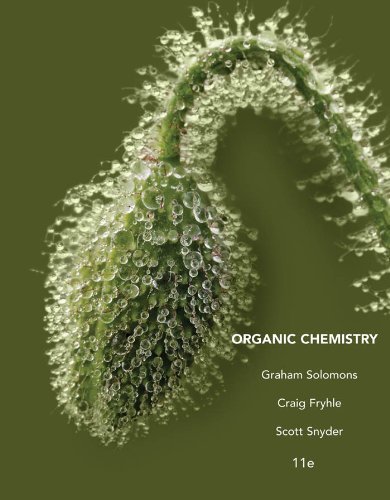Organic Chemistry 11th Edition by Solomons Fryhle Snyder – Test Bank
Digital item No Waiting Time Instant DownloadISBN-10: 1118978889 ISBN-13: 978-1118978887Author: Snyder Solomons, FryhlePublisher : Wiley; 11 edition
In Stock
Original price was: $55.00.$22.00Current price is: $22.00.
Organic Chemistry 11th Edition by Solomons Fryhle Snyder – Test Bank
Test Bank for Organic Chemistry, 11th Edition by Solomons, Fryhle, and Snyder
The “Test Bank for Organic Chemistry, 11th Edition” by T.W. Graham Solomons, Craig B. Fryhle, and Scott A. Snyder is an essential educational resource designed to support educators and students in mastering the principles and applications of organic chemistry. This comprehensive test bank complements the textbook by offering a diverse array of questions that assess and reinforce understanding of key organic chemistry concepts, making it an invaluable tool for both teaching and learning. Below is a detailed overview of the components and benefits of this test bank:
Overview of Test Bank Content
- Chapter-by-Chapter Organization
- The test bank is meticulously organized to align with each chapter of the textbook. This ensures comprehensive coverage of all critical topics, facilitating easy integration into the curriculum and enabling targeted assessments.
- Types of Questions
- Multiple-Choice Questions (MCQs): These questions cover a broad spectrum of knowledge, from basic recall to complex application and critical thinking. Each question includes well-crafted distractors to challenge students’ understanding.
- True/False Questions: These questions evaluate students’ ability to differentiate between correct and incorrect statements, reinforcing factual knowledge and addressing common misconceptions.
- Fill-in-the-Blank Questions: These questions focus on recalling specific details such as key terms, reaction mechanisms, and important concepts, testing students’ memory and understanding.
- Short Answer Questions: These questions require detailed yet concise responses, evaluating students’ ability to explain organic chemistry concepts clearly and accurately.
- Essay Questions: These questions assess students’ ability to synthesize and articulate complex ideas, demonstrating a deep understanding of organic chemistry principles and their applications.
- Problem-Solving Questions: Real-world problems and scenarios help students apply theoretical knowledge to practical situations, enhancing their critical thinking and problem-solving skills.
- Reaction Mechanism Questions: Detailed questions focusing on specific reaction mechanisms, requiring students to draw mechanisms, predict products, and understand the step-by-step process of reactions.
- Difficulty Levels
- Questions are categorized by difficulty to provide a range of challenges and assess students’ proficiency at different levels, including:
- Basic: Testing foundational knowledge and comprehension.
- Intermediate: Requiring application of knowledge to practical organic chemistry scenarios.
- Advanced: Involving critical thinking, analysis, and synthesis of complex organic chemistry information.
- Questions are categorized by difficulty to provide a range of challenges and assess students’ proficiency at different levels, including:
- Core Focus Areas
- Structure and Bonding: Questions covering the basics of atomic structure, molecular bonding, hybridization, and molecular geometry.
- Acids and Bases: Detailed coverage of acid-base theories, pKa values, and the role of acids and bases in organic reactions.
- Alkanes and Cycloalkanes: Assessing knowledge of the properties, nomenclature, and reactions of alkanes and cycloalkanes.
- Stereochemistry: Focus on chirality, enantiomers, diastereomers, and the physical and chemical properties of stereoisomers.
- Alkenes and Alkynes: Examining the structure, properties, and reactions of alkenes and alkynes, including addition reactions.
- Functional Groups: Questions on the properties, nomenclature, and reactions of various functional groups, including alcohols, ethers, amines, and carbonyl compounds.
- Substitution and Elimination Reactions: Coverage of nucleophilic substitution and elimination reactions, including reaction mechanisms and factors influencing reaction pathways.
- Aromatic Compounds: Assessing understanding of the structure, stability, and reactions of aromatic compounds, including electrophilic aromatic substitution.
- Spectroscopy and Spectrometry: Questions on the principles and applications of IR, NMR, and mass spectrometry in organic chemistry.
- Organic Synthesis: Focus on the strategies and methodologies used in the synthesis of complex organic molecules.
- Biomolecules: Examining the structure and function of carbohydrates, proteins, nucleic acids, and lipids in organic chemistry.
- Alignment with Learning Objectives
- Each question in the test bank is aligned with the learning objectives outlined in the textbook, ensuring that assessments are relevant and targeted towards achieving the intended educational outcomes. This alignment helps in accurately measuring students’ progress and comprehension.
- Educational Support and Utility
- For educators, the test bank provides a comprehensive resource for creating quizzes, exams, and other assessments. It simplifies the process of test creation and ensures consistency and alignment with the curriculum.
- For students, the test bank serves as a valuable tool for self-assessment and study, helping them identify areas of strength and weakness and focus their efforts on areas needing improvement.
Benefits of Using the Test Bank
- Enhanced Learning and Retention
- The diverse range of question types and difficulty levels helps reinforce learning through varied and repeated exposure to key concepts, enhancing retention and understanding.
- Preparation for Real-World Applications
- By focusing on real-world scenarios and practical applications, the test bank prepares students for the practical aspects of organic chemistry, ensuring they are ready to apply their knowledge in laboratory and research settings.
- Comprehensive Assessment
- The test bank allows for thorough and multi-faceted evaluation of students’ knowledge and skills, from basic understanding to advanced application, ensuring a well-rounded educational experience.
- Efficient Teaching Resource
- For educators, the test bank simplifies the process of creating assessments, providing a consistent and reliable tool for evaluating students’ progress and readiness for advanced studies in organic chemistry.
Conclusion
The “Test Bank for Organic Chemistry, 11th Edition” by T.W. Graham Solomons, Craig B. Fryhle, and Scott A. Snyder is an essential resource for organic chemistry education. It provides structured, comprehensive, and versatile tools for assessing and enhancing students’ knowledge and skills in organic chemistry. By aligning closely with the textbook and emphasizing real-world application, the test bank supports the development of competent, confident professionals ready to excel in their understanding and application of organic chemistry principles in various scientific and industrial settings.


Reviews
There are no reviews yet.